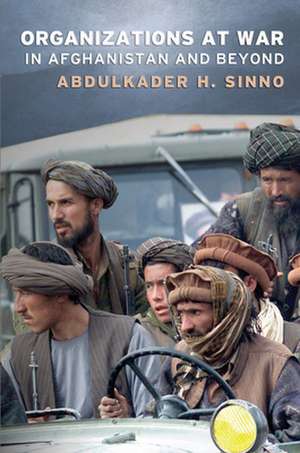Organizations at War in Afghanistan and Beyond
Autor Abdulkader H. Sinnoen Limba Engleză Paperback – 14 ian 2010
While popular accounts of warfare, particularly of nontraditional conflicts such as guerrilla wars and insurgencies, favor the roles of leaders or ideology, social-scientific analyses of these wars focus on aggregate categories such as ethnic groups, religious affiliations, socioeconomic classes, or civilizations. Challenging these constructions, Abdulkader H. Sinno closely examines the fortunes of the various factions in Afghanistan, including the mujahideen and the Taliban, that have been fighting each other and foreign armies since the 1979 Soviet invasion.Focusing on the organization of the combatants, Sinno offers a new understanding of the course and outcome of such conflicts. Employing a wide range of sources, including his own fieldwork in Afghanistan and statistical data on conflicts across the region, Sinno contends that in Afghanistan, the groups that have outperformed and outlasted their opponents have done so because of their successful organization. Each organization's ability to mobilize effectively, execute strategy, coordinate efforts, manage disunity, and process information depends on how well its structure matches its ability to keep its rivals at bay. Centralized organizations, Sinno finds, are generally more effective than noncentralized ones, but noncentralized ones are more resilient absent a safe haven.Sinno's organizational theory explains otherwise puzzling behavior found in group conflicts: the longevity of unpopular regimes, the demise of popular movements, and efforts of those who share a common cause to undermine their ideological or ethnic kin. The author argues that the organizational theory applies not only to Afghanistan-where he doubts the effectiveness of American state-building efforts--but also to other ethnic, revolutionary, independence, and secessionist conflicts in North Africa, the Middle East, and beyond.
Preț: 179.69 lei
Nou
Puncte Express: 270
Preț estimativ în valută:
34.39€ • 37.37$ • 28.91£
34.39€ • 37.37$ • 28.91£
Carte disponibilă
Livrare economică 31 martie-14 aprilie
Preluare comenzi: 021 569.72.76
Specificații
ISBN-13: 9780801475788
ISBN-10: 0801475783
Pagini: 352
Dimensiuni: 186 x 230 x 21 mm
Greutate: 0.48 kg
Editura: MB – Cornell University Press
ISBN-10: 0801475783
Pagini: 352
Dimensiuni: 186 x 230 x 21 mm
Greutate: 0.48 kg
Editura: MB – Cornell University Press
Notă biografică
Cuprins
1. Organizing to WinPart One: An Organizational Theory of Group Conflict
2. Organization and the Outcome of Conflicts
3. Advantages and Limitations of Structures
4. The Gist of the Organizational TheoryPart Two: Explaining the Outcomes of Afghan Conflicts
5. The Soviet Withdrawal from Afghanistan
6. Resilience through Division, 1979¿1989
7. The Cost of the Failure to Restructure, 1989¿1994
8. The Rise of the Taliban, 1994¿2001
9. Afghan Conflicts under U.S. Occupation, 2001¿Part Three: And Beyond...
10. The Organizational Theory beyond AfghanistanGlossary of Terms
Participants in Post-1978 Afghan Conflicts
References
Index
Descriere
Sinno closely examines the fortunes of the various factions in Afghanistan that have been fighting each other and foreign armies since the 1979 Soviet invasion, offering a new understanding of how their organizational structure determine success.
